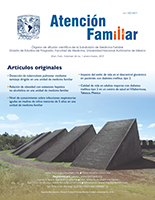Obesity Relation with Non-alcoholic Hepatic Steatosis in a Family Medicine Unit
Main Article Content
Abstract
Objective: To analyze the relation between obesity and non-alcoholic hepatic steatosis in a Family Medicine Unit (fmu). Methods: analytical cross-sectional study. The sample included 119 patients of both sexes, selected by a sampling for convenience, from 16 to 80 years, with no history of hepatic pathology, systemic chronic pathology, pregnancy or drug addiction, and who attended the fmu No. 75 in Morelia, Michoacán, México, from November 2016 to April 2017. Body mass index was calculated and laboratory studies were performed. Hepatic ultrasound was performed with which the diagnosis of non-alcoholic hepatic steatosis (nash) was established. The X2 test was used for difference in proportions and anova test for difference of three or more averages. A p<0.05 value was considered statistically significant. Results: 76 women and 43 men participated. 1.7% had low weight (n=2), 47.9% normal weight (n=57) and 50.4% overweight and obesity (n=60). 52.9% of the patients were diagnosed with nash (n=63). Overweight and obese patients showed a higher degree of nashcompared to those with a normal weight (P=0.000). Sedentary lifestyle patients showed a higher degree of nash compared to non-sedentary lifestyle (P=0.000). As greater degree of nash higher aspartate aminotransferase, alanine aminotransaminase and cholesterol values (P=0.000). Conclusion: Patients with overweight, obesity and sedentary lifestyle have a higher prevalence of non-alcoholic hepatic steatosis.
